#bilateria
Text
This just in, starfish are a radially symmetrical head with a stomach.
God I love echinoderms
If you told someone that there’s an entire group of animals that develop butt first as embryos are born bilateral but then grow a radially symmetrical head like a cancer in their side that then bursts out and lives as a completely separate organism from its birth form and moves via hydraulic systems…
They wouldn’t believe you. Yet one of the most beloved cartoon characters is one of them.
#biology#genomics#genome#genomes#genome sequencing#evolutionary biology#echinoderm#starfish#asteroidea#bilateria#Deuterostome#Deuterostomia
5K notes
·
View notes
Text
Strange Symmetries #03: Eerie Early Echinoderms
Represented today by starfish, brittle stars, sea urchins, sea cucumbers, and crinoids, the echinoderms have a characteristic five-way radial symmetry that makes them barely even recognizable as bilaterians. Their true ancestry is only revealed by their genetics and their larvae, which still retain bilateral symmetry – and the way they metamorphose into adults is bizarre, essentially growing a whole new radial body from within the left side of their larval body.
(Sea cucumbers and sand dollars are superficially bilateral as adults, but evolved this secondarily on top of their existing radial symmetry. And some adult echinoderms like starfish also seem to retain a little bit of "behavioral bilaterism", generally preferring to move with a specific arm always acting as their "front" end.)
The first known echinoderms appeared in the fossil record during the early Cambrian, about 525 million years ago, but the common ancestor of the whole group probably actually originated a few tens of millions of years earlier in the mid-to-late Ediacaran. Early echinoderms seem to have started off as flattened animals that sat on the seafloor filter-feeding, and with this largely immobile way of life their bodies started to shift into asymmetry, no longer constrained by the locomotory advantages of being bilaterally symmetric.
In fact, for these early sedentary filter-feeders being radial was actually much more advantageous, able to distribute sense organs all around their bodies and grab food from any direction without having to reposition themselves, converging on the lifestyle of non-bilaterian cnidarian polyps. The evolutionary transition from bilateral to asymmetrical to pentaradial seems to have happened incredibly quickly during the Cambrian Explosion, and all modern echinoderms probably evolved from a group called the edrioasteroids, maintaining their new base body plan even when they later began taking up more mobile lifestyles again.
But during the process of all that some very alien-looking lineages split off at various stages of anatomical weirdness.
Stylophorans had asymmetrical bodies with a single feeding arm at the front, and varied from irregular boot-like shapes to almost bilateral heart shapes depending on their specific ecologies. The highly asymmetrical forms were probably spreading their weight out over soft soupy mud in quiet waters, while the more bilateral forms may have been more streamlined to deal with stronger water currents.
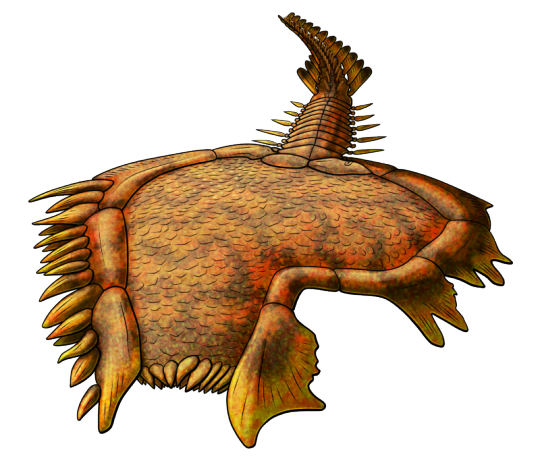
Sokkaejaecystis serrata was a stylophoran that lived during the late Cambrian, about 501-488 million years ago, in what is now South Korea. It was tiny, only about 1cm long (~0.4"), and its boot-shaped body was surrounded by spines and flanges that spread out its surface area and probably also made it much more awkward for small predators to attempt to eat.
———
Meanwhile the solutes started off as immobile animals living attached to the seafloor via a stalk-like appendage. But fairly early in their evolution they switched to a more active mode of life, modifying their stems into tail-like "steles" that were used to push themselves along.
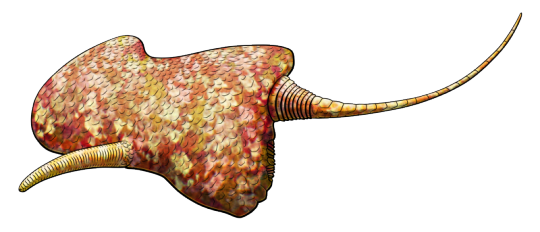
Maennilia estonica lived in what is now Estonia during the late Ordovician, about 450 million years ago. It was quite large for a solute at about 12cm long (~4.7"), with a sort of vaguely-trapezoidal body, a short feeding arm, and a long thin stele.
Both of these strange early echinoderm lineages were surprisingly successful, surviving for a good chunk of the Paleozoic Era alongside their more familiar radial relatives. The solutes lasted until the early Devonian about 400 million years ago, and the stylophorans continued all the way into the late Carboniferous about 310 million years ago.
———
NixIllustration.com | Tumblr | Twitter | Patreon
#science illustration#strange symmetries#paleontology#paleoart#palaeoblr#sokkaejaecystis#stylophora#maennilia#soluta#echinoderm#ambulacraria#deuterostome#bilateria#art#eldritch echinoderms#go home evolution you're drunk
506 notes
·
View notes
Text

17 notes
·
View notes
Text
if we don't make it
I don't know... if we don't make it. I do not worry much. The ants will take good care of the earth and their decedents will do Bilateria proud. I just know it.
This whole "semi-social monkey" thing never really made any sense if you think about it at all.
2 notes
·
View notes
Text
If you think there are at least some non-animal organisms, like archaea or fungi or all opisthokonts plants, that meet the stated criteria, select the first option ("Animals or other.") We're discussing terrestrial, biological life only, though, so extraterrestrial life, supernatural beings, or machine intelligences do not figure in to this scheme (but feel free to discuss them in the notes).
Eumetazoa is, AFAICT, the largest group of animals that includes all animals with at least some nervous tissue--so not sea sponges. But it does include a few clades without nervous systems, like the Placozoa.
Chordates are all animals containing a dorsal nerve cord specifically: chordates do not include, e.g., insects, molluscs (including octopuses and squid), and starfish. Chordates do include all fish.
Tetrapods include all animals with four limbs and distinct digits; this excludes most, but not all fish, and includes reptiles, mammals, dinosaurs (including birds), and amphibians.
Mammals includes all animals that nurse their young, have fur, have a neocortex, and have three middle ear bones. This group includes monotremes like the platypus, as well as more familiar animals like dogs, cats, cows, horses, mooses, and more(ses).
Primates includes monkeys, lemurs, apes, tarsiers, lorises and, of course, humans (though all of these clades include humans).
Hominids include gorillas, orangutans, chimpanzees, and humans ("apes").
Hominins includes just humans and chimpanzees (including bonobos). (I think; the taxonomic nomenclature distinguishes between Hominidae, Hominini, Homininae, Hominina, and Hominoidae, so I might have mixed some of these up. Blame the ICZN or whoever is responsible for this mess.)
Australopithecines (equivalent to "Hominina," I think, but don't quote me on that) includes all extinct hominins more closely related to humans than to any other extant species, like Australopithecus africanus, Paranthropus robustus, and of course later species like Neanderthals and Homo sapiens.
Homo is the genus that includes the whole human family in the broad sense: modern humans, Neanderthals, Denisovans, Homo erectus, and Homo habilis.
Homo sapiens includes only anatomically modern humans, as we emerged around 300,000 years ago in Africa.
#i really wanted like four or five more options#to make this poll with sufficient granularity#oh well#pretend eukaryotes bilateria vertebrates and placental mammals are also on the list#and possibly synapsids and the eukaryotes+archaea group just for fun
66 notes
·
View notes
Note
Birds are class Aves.
Sure, under Linnaean taxonomy. But, well,
A) Linnaeus was a eugenecist so his scientific opinions are suspect and his morality is awful
B) he didn't know about evolution
C) he didn't know about prehistoric life
so his classification system? Sucks ass. It doesn't work anymore. It no longer reflects the diversity of life.
Instead, scientists - almost across the board, now - use Clades, or evolutionary relationships. No rankings, no hierarchies, just clades. It allows us to properly place prehistoric life, it removes our reliance on traits (which are almost always arbitrary) in classifying organisms, and allows us to communicate the history of life just by talking about their relationships.
So, for your own edification, here's the full classification of birds as we currently know it, from biggest to smallest:
Biota/Earth-Based Life
Archaeans
Proteoarchaeota
Asgardians (Eukaryomorphans)
Eukaryota (note: Proteobacteria were added to an asgardian Eukaryote to form mitochondria)
Amorphea
Obazoa
Opisthokonts
Holozoa
Filozoa
Choanozoa
Metazoa (Animals)
ParaHoxozoa (Hox genes show up)
Planulozoa
Bilateria (all bilateran animals)
Nephrozoa
Deuterostomia (Deuterostomes)
Chordata (Chordates)
Olfactores
Vertebrata (Vertebrates)
Gnathostomata (Jawed Vertebrates)
Eugnathostomata
Osteichthyes (Bony Vertebrates)
Sarcopterygii (Lobe-Finned Fish)
Rhipidistia
Tetrapodomorpha
Eotetrapodiformes
Elpistostegalia
Stegocephalia
Tetrapoda (Tetrapods)
Reptiliomorpha
Amniota (animals that lay amniotic eggs, or evolved from ones that did)
Sauropsida/Reptilia (reptiles sensu lato)
Eureptilia
Diapsida
Neodiapsida
Sauria (reptiles sensu stricto)
Archelosauria
Archosauromorpha
Crocopoda
Archosauriformes
Eucrocopoda
Crurotarsi
Archosauria
Avemetatarsalia (Bird-line Archosaurs, birds sensu lato)
Ornithodira (Appearance of feathers, warm bloodedness)
Dinosauromorpha
Dinosauriformes
Dracohors
Dinosauria (fully upright posture; All Dinosaurs)
Saurischia (bird like bones & lungs)
Eusaurischia
Theropoda (permanently bipedal group)
Neotheropoda
Averostra
Tetanurae
Orionides
Avetheropoda
Coelurosauria
Tyrannoraptora
Maniraptoromorpha
Neocoelurosauria
Maniraptoriformes (feathered wings on arms)
Maniraptora
Pennaraptora
Paraves (fully sized winges, probable flighted ancestor)
Avialae
Avebrevicauda
Pygostylia (bird tails)
Ornithothoraces
Euornithes (wing configuration like modern birds)
Ornithuromorpha
Ornithurae
Neornithes (modern birds, with fully modern bird beaks)
idk if this was a gotcha, trying to be helpful, or genuine confusion, but here you go.
all of this, ftr, is on wikipedia, and you could have looked it up yourself.
671 notes
·
View notes
Text
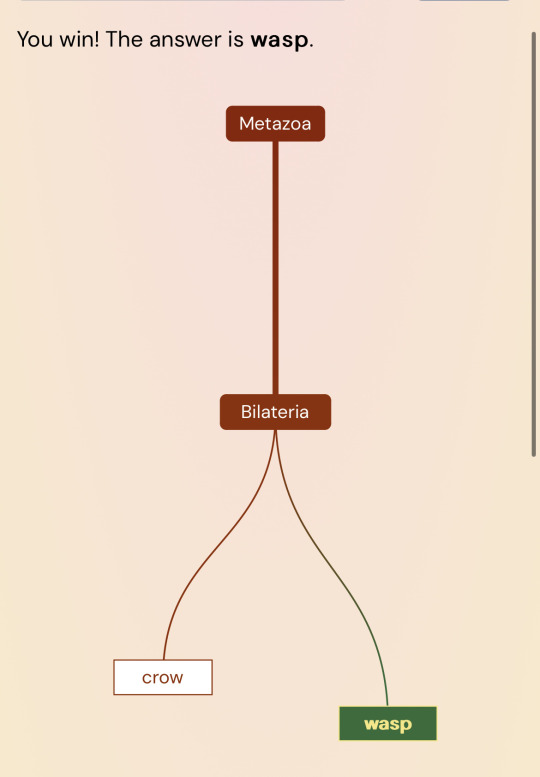
YAAAAY i always guess wasp first when i get bilateria and i finally got it
16 notes
·
View notes
Text
Day 1 - 25/02/24
Monarch Butterfly (Danaus Plexippus)
m6/2

First up is the monarch butterfly! I had a slight bit of trouble with this one because the picture on the wikipedia page for bilateria changed, which threw me off for some reason. I got there in the end, though, with not a terrible score.
3 notes
·
View notes
Text
Metazooa

[ID: Metazooa, the cladistics puzzle tree, guessed in 7. Branching at bilateria, under gnathostomata is cockatiel and tiger shark. Then on the other branch, under pancrustacea is cockroach. Then theres eumalacostraca, with an additional branch to pleocyermata, hermit crab and loberster. The last guesses just under eumalacostraca are mantis shrimp, and the answer pillbug. END]
BUGS IS CRAB
4 notes
·
View notes
Text
EAT UP FRONT ROE FELLAS, IT'S TIME FOR HEADCANNONS‼️

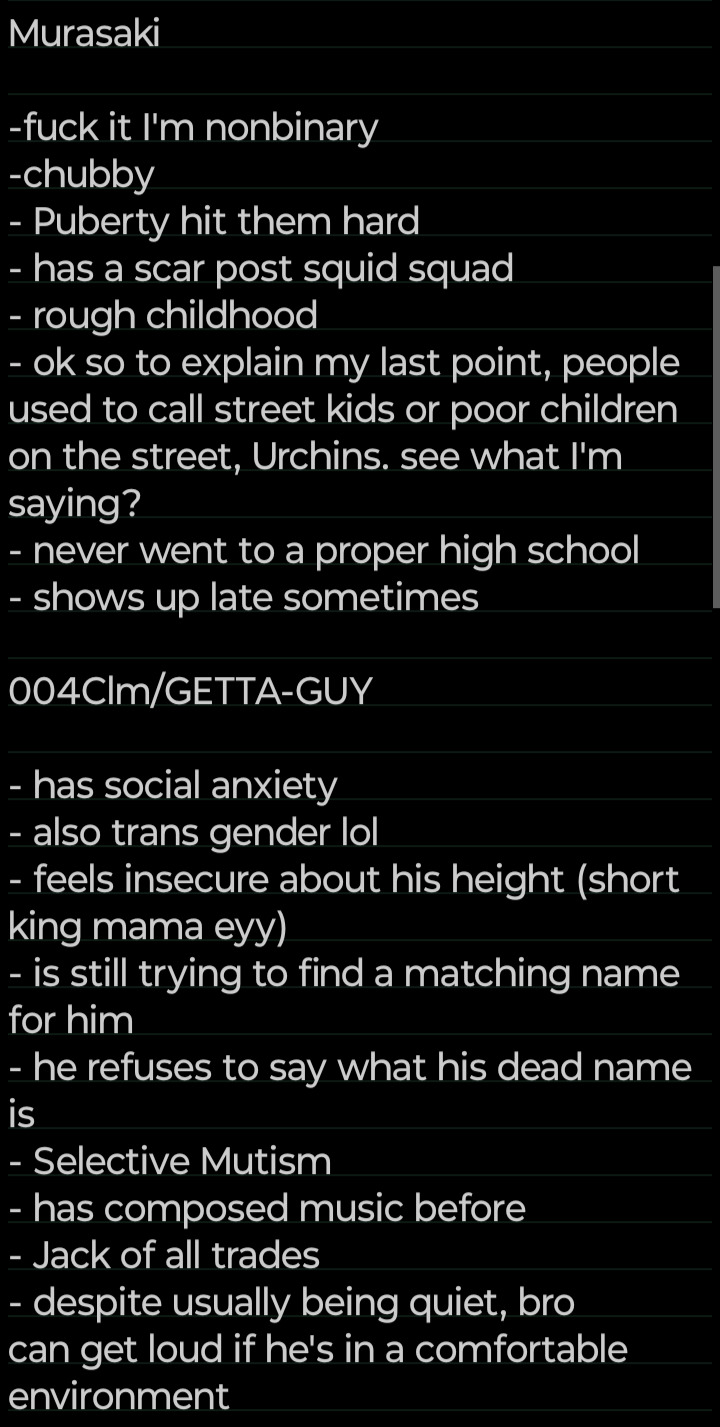


Note: I made a mistake on ClmSaki part, they're both Bilateria, not Mollusks.
Also debating on whether or not to leave because of A| or staying here, I think I'll push forward because I'm petty and because I have hope this is a fad like en eff tees, I might make a drawing of Ichiya with a pencil

I don't want to lose this community or circle that I have created that has made me comfortable so I will continue to push for them
#splatbands#splatoon headcanon#front roe#ichiya#ichiya splatoon#namida splatoon#namida#murasaki splatoon#murasaki#004clm#splatoon#kinnie.txt#polyroe
4 notes
·
View notes
Text
Currently extremely invested in the taxonomy of Dungeons and Dragons. (also something something 2000% of your normal dopamine) Also known as how the existence of Bones is currently ruining my life.
So.
To start off with, most Dnd creatures are clearly vertebrates. They got a spinal chord. They got a post-anal tail. They got Bilateral Symmetry. Most of them are probably also Gnathostomata, meaning they have a jaw bone. This is not the case for, say, Aboleths, who visibly don't. This means the last common ancestor between Humans and Aboleths assuming evolution is a factor is between approx. 520 and 420 MYA. If they are more distantly related, or from the elemental plane of water, like some of the lore says, they could still be animals, but probably not Chordata. In any case, not closely related enough for the problem I'm thinking about. I will come back to Aboleths in a minute. Also, oozes, extraplanar entities, and other obvious "non-animals" like shambling mounds which might plausibly be aliens or products of magic can equally plausibly have a whole different evolution. I am leaving aside the obvious issue of "how can you get tieflings or aasimar when humans and angels or demons fuck" to which the answer is obviously magic, they're extraplanar. Also, given that interbreeding between humans, elves, dwarves, and orcs is well established, they can't realistically be different species. Biologically, that taxonomy is pretty clear cut.
Methodologically, I'm assuming evolution is a factor and that there isn't a "lets make all the critters" origin story, although that would probably vary by world. Also conceivably any single entry on this list could have been cooked up by a fucked up wizard, but I Am Just Going To Assume That The Majority Of Species Have Natural Origins. Magic doing fucked up things to a creature and making biologically impossible things is a natural origin. Blink Dogs are in the family Canidae. You would want to put Displacer Beasts in the family Felidae but Oh Boy.
Your average Dnd Regular Animal but Magic that you run into probably has bones. We know, at least, that dragons have bones because they are a crafting ingredient. Pegasus, Displacer beasts, Aarakocra, etc. are probably not Just Cartilage, I'm assuming. The fact that dragons certainly do is enough though to establish that there is a lineage of 6 limb boned creatures.
However there is a problem: In real life, when jawed vertebrates split up into boned fish and non-boned Fish, we already had the 4 limb symmetrical body plan.
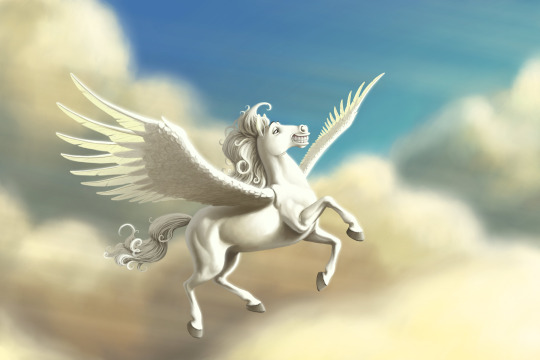
This motherfucker has 6 paired limbs. [image id. A pegasus]

So does this one. [Image id. A Blue Dragon]
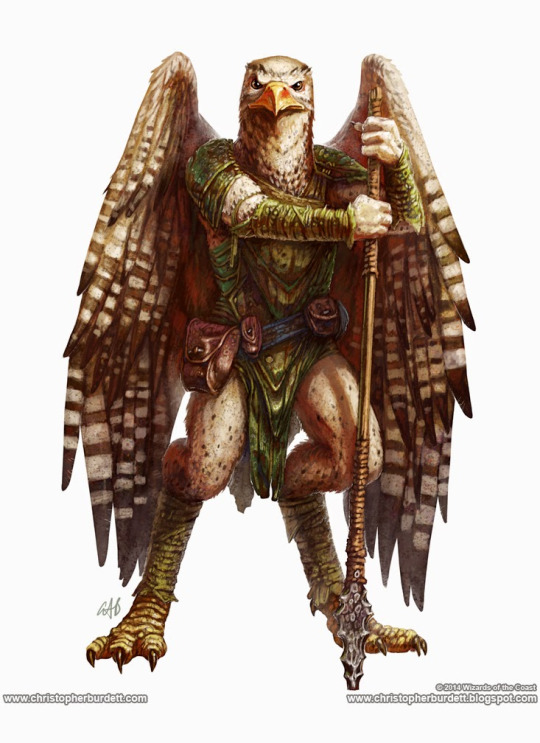
And Hey Look at That. [Image id. An Aarakocra] (Another piece of this is that virtually all DnD examples have nostrils. This places them in the clade of Olfactores which means that they are not Cephalochordata, aka Lancelets.)
But Sharks only have 4 limbs, and no bones.

[Image id. A labeled diagram of a shark]
The anal fin, which is the closest thing to 5th and 6th limbs, is a medial fin meaning it runs down the middle and isn't paired. In order to get things with more than 5 limbs, we need to go back further.
How much further? Depends.
Would you rather have dragons be closer related to starfish or bees?
See all the animals we're looking at are definitely Bilateria. They have bilateral symmetry consistent with what you'd see on everything from Cephalopods, a kind of Mollusk, to Vertebrates, which these animals we're talking about definitely are. (If at this point you are thinking I am dumb and that 6 limbs is just creative licence stick with me) Once you go back to the point in common ancestry where you have arthropods and cephalopods on the one hand and vertebrates on the other it's pretty easy to find a common ancestor which explains the 6 limb body pattern. I'm not happy with this answer though, because starfish are closer relatives of humans than arthropods or cephalopods, and according to this hypothesis that would mean starfish are closer relatives to humans than pegasus, Displacer beasts, Bullettes, and all the other wacky monsters which are normal vertebrates with an extra set of limbs. We have Bones in common. We have Nostrils in common. The Extra Limbs should not divide us.
(Fun biology fact: What we have in common with Starfish but not Insects is that when we and starfish were embryos, we formed asshole first, unlike bugs, who decided a mouth was a higher priority. Some humans have not developed past this step.)
So now I come to my hypothesis: it is easier to lose limbs than it is to gain them. (Look at snakes.) Growing a random extra limb somewhere weird is easier than growing two limbs with bilateral symmetry. Therefore, reaching back in the Dnd evolutionary record, we must conclude that in order for there to be contemporary 6 limb and 4 limb vertebrates in the clade Olfactores the first vertebrates must have had 6 limbs, and that the branch of vertebrate evolution which resulted in humans and other 4 limb life must have lost a pair of limbs along the way. What this doesn't explain is the convergent evolution in terms of 4 and 6 legged mammals, amphibians, reptiles, and birds, each being extremely similar whether you are looking at the 4 or 6 legged varieties. Even convergence at all would be remarkable, much less the convergence of displacer beasts being near identical to comparable 4 limbed big cats. (I'm not worrying about the tentacles right now, that shit's magic) The convergence, for example, between the cocatrice and wyvern and the dragon morphologically demands a different explanation.
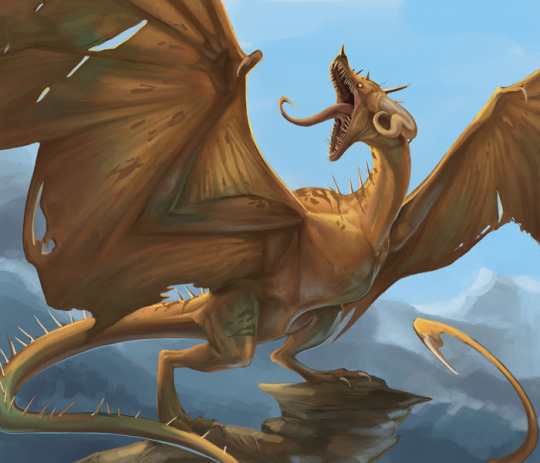
[Image id. A wyvern, which is morphologically extremely similar to a dragon minus the forelimbs.]
However, there would still be a biological record of a convergence that evolutionarily recent, meaning vestigial remains of the bone and muscle structure that supported the extra pair of limbs would remain, potentially meaning that just like how some modern humans can wiggle their ears, some dnd humans could potentially learn to wiggle their shoulder blades.
Also coming back to aboleths if they're chordata (big if, would require observation of Aboleth embryo) that means that the connection between the ancient mind flayer empire and the ancient aboleth empire which was supposed to be one and the same requires a new explanation because mind flayers are clearly mollusks engaged in human parasitism. However, if they are mollusks the connection remains possible.
15 notes
·
View notes
Text
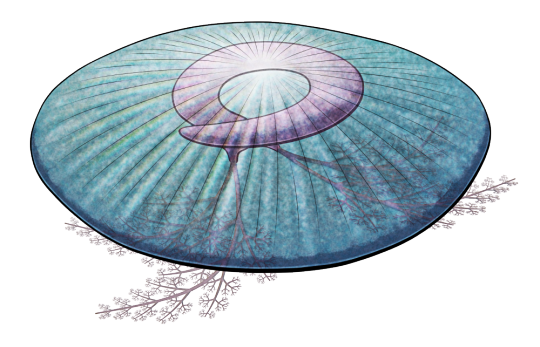
Strange Symmetries #05: Enigmatic Eldoniids
Fossils of cambroernids were first discovered in the early 1900s, but these Paleozoic animals were so confusing that for a long time their evolutionary relationships were a mystery.
They had coiled bodies and fractal-branching feeding tentacles, and they ranged in shape from worm-like to cup-like to disc-like. Historically various species were classified as sea cucumbers, jellyfish, tunicates, gnathiferans, or lophophorates, but more recently they've been recognized as a single united lineage of ambulacrarians, closely related to modern echinoderms and hemichordates.
Discophyllum peltatum lived during the late Ordovician, about 458-448 million years ago, in what is now New York, USA. Up to around 11cm in diameter (~4.3"), it was one of the disc-shaped cambroernids – a lineage known as eldoniids – with a shallow domed body containing a clockwise-coiling sac and delicate feeding tentacles around its mouth.
Its disc would have been tough but flexible, containing numerous supporting radial structures that were probably part of a fluid-filled hydrostatic skeleton, giving it an almost-radially-symmetric body plan superficially resembling a jellyfish.
The lifestyle of eldoniids is still uncertain, but they seem to have mostly sat on the seafloor, possibly extending their tentacles out from under their discs to grab nearby food.
———
NixIllustration.com | Tumblr | Twitter | Patreon
#science illustration#strange symmetries#paleontology#paleoart#palaeoblr#discophyllum#eldoniid#cambroernida#ambulacraria#deuterostome#bilateria#art
366 notes
·
View notes
Text
DID MY METAS TONIGHT. cheated a little but didnt lose which ill take

beefed it soooooo hard on zooa im so out of practice i doubted my instinct to go insectual at bilateria so it took me ages to narrow down lol. made a beautiful wide-spanning tree. but YAY the humble house fly
flora. guessed a bunch of random plants trying to jog my memory. gave up opened the wiki pages narrowed down from the first plant listed for each successive family lol. WELL. i got it <3
3 notes
·
View notes
Text
Evolution of tissue-specific expression of ancestral genes across vertebrates and insects [ Bilateria ]
Evolution of tissue-specific expression of ancestral genes across
vertebrates and insects [Highlights]
Regulation of gene expression is arguably the main mechanism underlying the
phenotypic diversity of tissues within and between species.
Seven hundred million years ago, a remarkable creature emerged for the
first time. Though it may not have been much to look at by today’s…
As per the study,…

View On WordPress
0 notes
Text
Echinoderms? In my Bilateria?
Who put seastars in Bilateria though sgkjfsafh I do not remember that. That's so funny that they start as bilateral embryos and then go "actually, I know we just evolved bilateral body plans, but let's be radial instead lol."
1 note
·
View note
Note
the spine is a segmented body part & thus has always been easily repeatable (see: convergently snaky lineages of reptiles) but AFAIK chordate organs never have been—fish can’t easily duplicate their hearts either—and it’s a combination of cephalization, segmentation, and metamerism. Cephalization tends to produce organs like complex brains, which then can’t be easily repeated throughout your segments for energy cost reasons. Segmentation and metamerism describe structural elements in development and whether something can be easily repeated; things which are segmented are easy to duplicate, things which derive from metameres can also be repeated easily, but if a body part isn’t segmented or your metameres fuse together in development into complex tagmata (the insect head, for instance) they get hard to repeat again.
I’m pretty sure this “split” (having many unfused metameres vs. having very few) can’t be exactly pinpointed but I would guess most of it for chordates happened sometime after the deuterostome/protostome split, and more of it happened sometime around the Echinodermata/everyone else split, echinoderms being the only deuterostomes I can think of with even vaguely similar modularity to arthropods. It’s possible for many sea stars to just add legs in development (Pycnopodia helianthoides develop at least 16 legs but may have as many as 24) with no ill effects.
It also seems easier for the Bilateria generally to go from singular to paired than from anything to triplicate (see: zero extant animal lineages with triradial symmetry, and only one extinct, RIP Trilobozoa; ancient fish probably had one swim bladder, but most modern species have two; cephalopods have three hearts but it’s actually a singular systemic heart and a pair of branchial hearts). Bilaterians, echinoderms excepted, really like pairs of things.
fascinating! thanks for the info.
18 notes
·
View notes